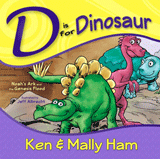
Duck-billed Dinosaur's Cranial Crest Has Paleontologists Crowing
News to Know
Abstract
A cranial crest does not a bird make.
News Source
- National Geographic: “Dinosaur Fossil With Fleshy Rooster’s Comb Is First of Its Kind”
The duck-billed dinosaur Edmontosauraus regalis had a fleshy crest on top of its head. Paleontologists preparing to transport it from its resting place in Alberta, Canada, were using a saw and chisel to carve the fossil into manageable pieces when they sliced into a hitherto unknown feature in this sort of dinosaur. They report in Current Biology that this “mummified duck-billed dinosaur” had a “soft-tissue cock’s comb.”1
“I was just expecting there to be rock, and all of a sudden there was skin underneath, and I thought to myself, ‘Whoops,’” says paleontologist Phil Bell of the University of New England, Australia. “We know that lots of dinosaurs had different kinds of head ornaments, but these are all made of bones. There's never been any indication that any dinosaurs had something like this, so this was totally out of left field.”
Boneless Crest Wasn’t For Crowing
The dinosaur’s skull was found in the Upper Cretaceous Wapiti Formation in Alberta, Canada. Many fossils of these duck-billed dinosaurs have been found in North America, but none with a crest has ever been found. CT scans confirm that this crest—unlike crests associated with other species of dinosaurs like Parasaurolophus—has no association with bony air passages nor any skull bones protruding into it. “This was a real surprise,” Bell says. “Not only did we have skin associated with the head, but also this completely bizarre structure.”
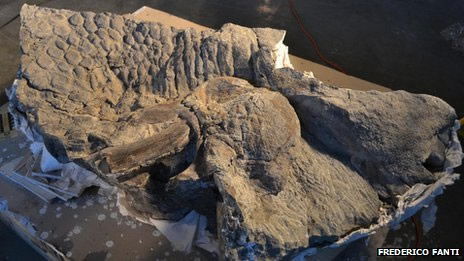
Paleontologists found this fossilized skull in Upper Cretaceous rock in Alberta, Canada. When carving up the large fossil for ease of transport, they discovered it had a cranial crest. CT scans confirmed the crest was not associated with bony support or bony air passages. Image by Frederico Fanti in “Dinosaur mummy’s fleshy head crest,” BBC Nature News.
“Bony crests are present in many hadrosaurids, but no soft-tissue cranial crests have been previously described for any dinosaur,” Bell and colleagues write. “Despite the discovery of several superbly preserved Edmontosaurus ‘mummies,’ no evidence of a soft cranial crest has been previously identified.”2 From their evolutionary point of view, the paleontologists are trying to figure out the evolutionary pressure that would have prompted the crest to develop. They assume that the bony crest in other hadrosaurid specimens (like Parasaurolophus) was lost through evolutionary processes but “substituted in Edmontosaurus by a fleshy display structure,” adding, “It also implies that visual display played a key role in the evolution of hadrosaurine crests and raises the possibility of similar soft-tissue structures among other dinosaurs.”3 They write, “The discovery of a fleshy crest in Edmontosaurus regalis reveals that some later hadrosaurines did not in fact lose their ornamentation but evolved an alternative solution to the bony crests that were widespread within the clade.” But the discovery of the fleshy crest “reveals” no such thing. It is only the assumption of evolution that “reveals” this gross generalization.
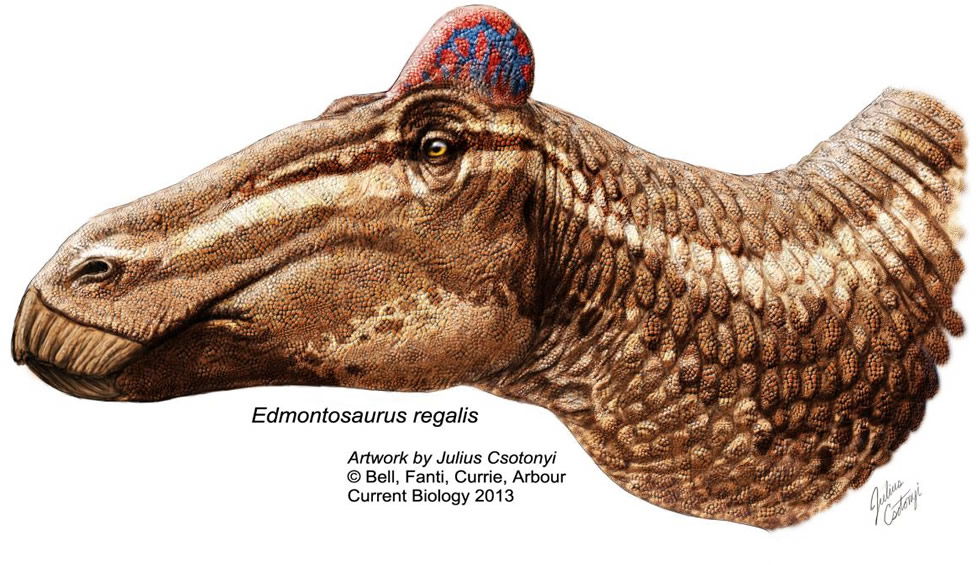
This is an artist’s representation of how the fleshy crest on the duck-billed dinosaur’s head might have looked. Crests on the heads of Parasaurolophus dinosaurs are associated with bony air passages and are therefore thought to have been used to produce sounds. No bones or air passages were associated with this dinosaur’s crest, however, in the CT images of the fossil. Image by Julius Csotonyi ©Bell, Fanti, Currie, Arbour, Current Biology 2013 National Geographic.
There is of course the possibility that this kind of dinosaur (or a sub-variety within this kind) actually had fleshy crests that were simply not preserved in the previously discovered fossils. “The actual bones of Edmontosaurus have absolutely no indication that there's a crest of any sort in this animal, so similar crests or other fleshy structures could have been really widespread among dinosaurs,” Bell says. “The fact that we have no evidence on the bones apparently means nothing about the external appearance of these animals.”
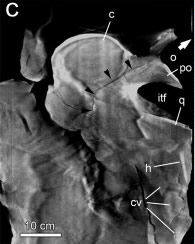
This X-ray image shows that the duck-billed dinosaur’s crest (c) was not associated with any bony structures but rests atop the skull, somewhat behind the eyes. (The orbit is labeled “o.”) Image: Phil R. Bell, Federico Fanti, Philip J. Currie, and Victoria M. Arbour, “A Mummified Duck-Billed Dinosaur with a Soft-Tissue Cock’s Comb,” Current Biology 24, no. 1 (December 12, 2013):70–75, doi:10.1016/j.cub.2013.11.008.
Rapid Burial (Sounding Familiar?)
“Soft tissues rarely fossilize,”4 the authors acknowledge. “For the skin to preserve, these animals had to be buried very rapidly, probably within a day or two after they died, and the chemical environment in the sediment was just right,” Bell says. Thus he acknowledges that it is entirely possible that other dinosaurs may have had crests just like this one but the crests were not preserved.
Thus, the authors write, “Alternatively, fleshy crests may have appeared earlier in hadrosauroid evolution and were simply retained in E. regalis following the loss of a bony display structure.”5 Nevertheless, they assume that this “evolutionary branch” of dinosaurs began with the unornamented Acristavus about 79 million years ago and continued to evolve over several million years to produce the crested Edmontosaurus regalis, about 72.58 million years ago.6
Since the crest anatomy—specifically its lack of any bony association—suggests that the crest was not used for any sort of respiratory or vocalizing function, paleontologists naturally wonder about the purpose of the crest. They write, “Explanations concerning hadrosaurid crest function have included visual display, olfaction, thermoregulation, and vocalization. However, most of these hypotheses are based on the hypertrophied nasal passages that invade the bony crests of lambeosaurine hadrosaurids. The crest observed in E. regalis differs considerably from those of all other crested hadrosaurids in its absence of osseous support.”
Again, from an evolutionary point of view, even an ornamental structure must have had, they believe, some sort of evolutionary pressure selecting it and prompting it to evolve. “A soft crest would have been impractical for defense or intraspecific combat and would have conferred no mechanical advantage to the skull,” they write. “Similarly, the relatively small size of the crest could not have stored enough fat to serve as an energy reserve for a full-grown, eight-ton Edmontosaurus. The function of a hadrosaurine soft crest therefore requires an alternative explanation, most likely related to either social signaling or sexual selection.”7
Crest or Comb?
Drawing conclusions about the evolutionary pressure that might have prompted the duck-billed dinosaur to develop and keep a crest without non-ornamental uses, Bell compares the structure to a comb like that found on roosters, grouse, and condors. “They use these to get the girls, basically—to indicate how fertile and how strong the male is,” Bell says. “Perhaps the male with the biggest and brightest crest was the leader of the pack, so to speak.” The researchers consider the cranial crests of various birds to be “the best analogy for the crest in E. regalis” and draw their conclusions about its presumed use from the behavior of modern birds.

The rooster, like many other birds, has a fleshy “cock’s comb,” or crest, atop its head. Birds are not the only animals having such fleshy crests, but paleontologists who discovered a duck-billed dinosaur with such a crest believe the supposed evolutionary relationship between dinosaurs and birds makes the cock’s comb the best modern analogue for the dinosaur’s newly discovered anatomical feature. But this too is a speculative belief, not scientific fact. Image by Mohammad Mahdi Karim, via Wikimedia Commons.
Ornamental structures are often used by various types of animals for visual signals in their social interactions. However, the authors state that their belief that birds evolved from dinosaurs in addition to the general resemblance is the basis for their just-like-a-rooster’s conclusions. They write, “The morphological similarity between the combs of E. regalis and modern avians, as well as their relatively close phylogenetic affinity—in combination with the aforementioned reasonings—suggest that the hadrosaurine comb played a major functional role in visual (presumably sexual) signaling.”8
While it is certainly reasonable that the duck-billed dinosaur likely used its crest for some sort of ornamental social or sexual signaling purpose, it is unnecessary to come up with an evolutionary scenario to explain its appearance. We do not know what the original kinds of dinosaurs looked like, but ornamental variations can be understood in the same way as variations in appearance among living kinds of animals—as expressions of vast amount of genetic information that was present in the DNA of first animals supernaturally made by God during Creation Week. The evolutionary just-so explanation is pure speculation flowing out of the evolutionists’ rejection of the testimony of the Creator in Genesis 1.
Furthermore, nothing about the crest supports an ancestral association or other phylogenetic relationship between dinosaurs and birds. The green basilisk lizard of Central America has a high head crest with which it impresses females. The researchers ignore the existence of a lizard like this, which has an ornamental head crest, and jump to birds for their analogous animal. In fact, they spend a substantial portion of their paper in Current Biology discussing this analogy. Yet nothing about the crest’s existence or anatomy demonstrates that it has anything to do with bird anatomy.
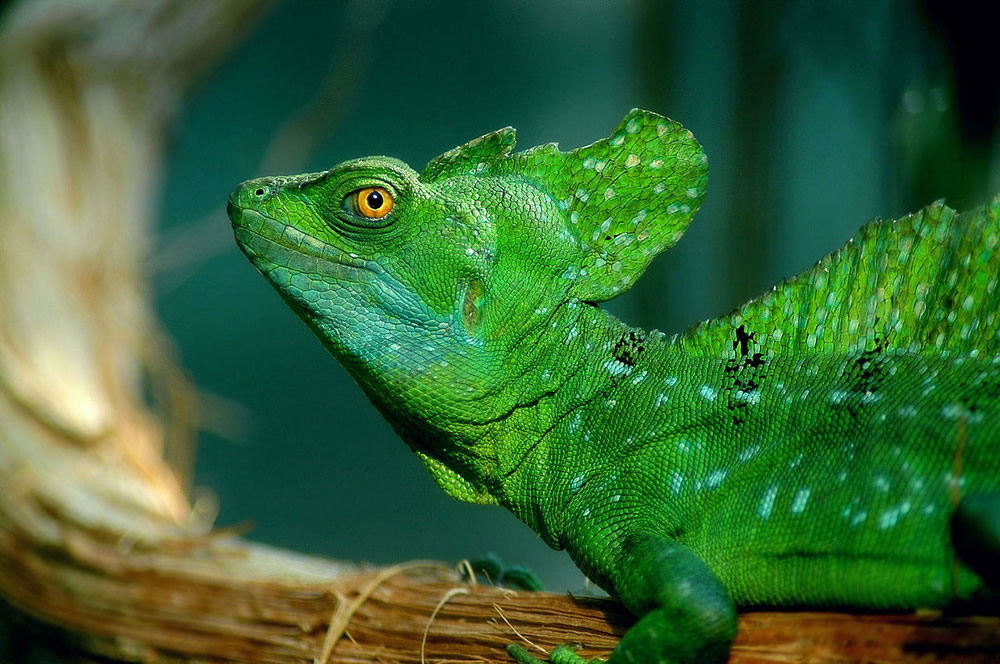
The male green basilisk lizard is also called the double-crested lizard because it has ornamental plumes on its head and back. A kind of iguana, it uses its crests to impress females. Perhaps the duck-billed dinosaur used the fleshy crest on its head for similar purposes. Of course, such behavior does not fossilize, so we can only speculate. Image by Fir0002, via Wikimedia Commons.
God created all kinds of land animals—including dinosaurs—about 6,000 years ago on the 6th day of Creation Week. He created the various kinds of birds on the 5th day (before He created dinosaurs on the 6th day), not millions of years later after dinosaurs through evolutionary processes. He created the different kinds of animals with genetic information to produce great variety, but only within their own created kinds. For this reason the opening verses of Genesis state that the various animals were created “after their kinds” and plants yield seed and fruit “according to its kind.” And biological observations reveal that living things do reproduce after their “kind.”
Observation and Speculation
Assumptions that life evolved from lifeless elements and then gradually became more complex are imaginative notions not supported by any actual biological observations. Furthermore, the belief that the layers in the fossil record were laid down over millions of years is founded on worldview-based unverifiable presuppositions.
The fossil record makes sense when viewed not as the order in which living things evolved—a process not observable in biology—but as a record of the order in which living things were buried, much of it being laid down in connection with the global Flood of Noah’s day. Read more about this in “Doesn’t the Order of Fossils in the Rock Record Favor Long Ages?”
A Flood? Really?

This are some of the beautifully preserved scales on the neck of the duck-billed dinosaur found in Alberta. Scale bar=1 cm. Image by P. Bell et al., via Current Biology.9
The paleontologist who found the crested duck-billed dinosaur was correct that preservation of soft tissue demands special conditions, in particular, rapid burial. In fact, not only the crest but also the scales and the wrinkles on the skin of this dinosaur were beautifully preserved. (See the illustration!) The “undulating and partly wrinkled”10 skin on the back of the neck appeared to result from the dinosaur’s death posture, with its head arched sharply backward. Like many dinosaurs, this one was preserved “in a characteristic ‘death pose’ with the neck and skull tightly retracted over the back.”11 This “death posture”—with the head thrown back, the tail extended or arched upward, and the mouth open—is quite common among dinosaur fossils—so much so it has a name: the opisthotonic death posture. Research has suggested that death associated with immersion in water produces this posture. The violent rising waters of the global Flood would have provided the loads of sediment needed to catastrophically bury billions of animals and plants, triggering opisthotonus in dying dinosaurs and ultimately providing the conditions that preserved many as fossils.
Thus this crested duck-billed dinosaur’s existence and preservation makes sense in terms of biblical history. No evolution was required to produce it, however, as it was descended from the kinds of dinosaurs God created about 6,000 years, and the global Flood provided the water-borne sediment to preserve it for us to see today.
Further Reading
- Baby Parasaurolophus Crest Joined the Chorus Early
- Were Birdbrains on the Dinosaur Pre-flight Checklist for Evolution?
- Paleo-sorting Morphs Three Dinosaurs into One
- Fossils Fail to Transition from Dinosaur Legs to Bird Wings
- Bird-mimicking Dinosaurs
- What Are “Kinds” in Genesis?
- Doesn’t the Order of Fossils in the Rock Record Favor Long Ages?
For More Information: Get Answers
Remember, if you see a news story that might merit some attention, let us know about it! (Note: if the story originates from the Associated Press, FOX News, MSNBC, the New York Times, or another major national media outlet, we will most likely have already heard about it.) And thanks to all of our readers who have submitted great news tips to us. If you didn’t catch all the latest News to Know, why not take a look to see what you’ve missed?
(Please note that links will take you directly to the source. Answers in Genesis is not responsible for content on the websites to which we refer. For more information, please see our Privacy Policy.)
Footnotes
- P. Bell et al., “A Mummified Duck-Billed Dinosaur with a Soft-Tissue Cock’s Comb,” Current Biology 24, no. 1 (December 12, 2013): 70–75, doi:10.1016/j.cub.2013.11.008.
- Ibid.
- Ibid.
- Ibid.
- Ibid.
- Ibid.
- Ibid.
- Ibid.
- Ibid.
- Ibid.
- Ibid.
Recommended Resources

Answers in Genesis is an apologetics ministry, dedicated to helping Christians defend their faith and proclaim the good news of Jesus Christ.
- Customer Service 800.778.3390
- © 2024 Answers in Genesis




